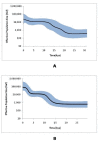Population expansion in the North African late Pleistocene signalled by mitochondrial DNA haplogroup U6
- PMID: 21176127
- PMCID: PMC3016289
- DOI: 10.1186/1471-2148-10-390
Population expansion in the North African late Pleistocene signalled by mitochondrial DNA haplogroup U6
Abstract
Background: The archaeology of North Africa remains enigmatic, with questions of population continuity versus discontinuity taking centre-stage. Debates have focused on population transitions between the bearers of the Middle Palaeolithic Aterian industry and the later Upper Palaeolithic populations of the Maghreb, as well as between the late Pleistocene and Holocene.
Results: Improved resolution of the mitochondrial DNA (mtDNA) haplogroup U6 phylogeny, by the screening of 39 new complete sequences, has enabled us to infer a signal of moderate population expansion using Bayesian coalescent methods. To ascertain the time for this expansion, we applied both a mutation rate accounting for purifying selection and one with an internal calibration based on four approximate archaeological dates: the settlement of the Canary Islands, the settlement of Sardinia and its internal population re-expansion, and the split between haplogroups U5 and U6 around the time of the first modern human settlement of the Near East.
Conclusions: A Bayesian skyline plot placed the main expansion in the time frame of the Late Pleistocene, around 20 ka, and spatial smoothing techniques suggested that the most probable geographic region for this demographic event was to the west of North Africa. A comparison with U6's European sister clade, U5, revealed a stronger population expansion at around this time in Europe. Also in contrast with U5, a weak signal of a recent population expansion in the last 5,000 years was observed in North Africa, pointing to a moderate impact of the late Neolithic on the local population size of the southern Mediterranean coast.
Figures


Similar articles
-
Divorcing the Late Upper Palaeolithic demographic histories of mtDNA haplogroups M1 and U6 in Africa.BMC Evol Biol. 2012 Dec 3;12:234. doi: 10.1186/1471-2148-12-234. BMC Evol Biol. 2012. PMID: 23206491 Free PMC article.
-
The history of the North African mitochondrial DNA haplogroup U6 gene flow into the African, Eurasian and American continents.BMC Evol Biol. 2014 May 19;14:109. doi: 10.1186/1471-2148-14-109. BMC Evol Biol. 2014. PMID: 24885141 Free PMC article.
-
The Expansion of mtDNA Haplogroup L3 within and out of Africa.Mol Biol Evol. 2012 Mar;29(3):915-27. doi: 10.1093/molbev/msr245. Epub 2011 Nov 16. Mol Biol Evol. 2012. PMID: 22096215
-
African human mtDNA phylogeography at-a-glance.J Anthropol Sci. 2011;89:25-58. doi: 10.4436/jass.89006. Epub 2011 Mar 15. J Anthropol Sci. 2011. PMID: 21368343 Review.
-
The archaeogenetics of Europe.Curr Biol. 2010 Feb 23;20(4):R174-83. doi: 10.1016/j.cub.2009.11.054. Curr Biol. 2010. PMID: 20178764 Review.
Cited by
-
Carriers of mitochondrial DNA macrohaplogroup R colonized Eurasia and Australasia from a southeast Asia core area.BMC Evol Biol. 2017 May 23;17(1):115. doi: 10.1186/s12862-017-0964-5. BMC Evol Biol. 2017. PMID: 28535779 Free PMC article.
-
MtDNA analysis of global populations support that major population expansions began before Neolithic Time.Sci Rep. 2012;2:745. doi: 10.1038/srep00745. Epub 2012 Oct 18. Sci Rep. 2012. PMID: 23082240 Free PMC article.
-
Carriers of Mitochondrial DNA Macrohaplogroup N Lineages Reached Australia around 50,000 Years Ago following a Northern Asian Route.PLoS One. 2015 Jun 8;10(6):e0129839. doi: 10.1371/journal.pone.0129839. eCollection 2015. PLoS One. 2015. PMID: 26053380 Free PMC article.
-
The first modern human dispersals across Africa.PLoS One. 2013 Nov 13;8(11):e80031. doi: 10.1371/journal.pone.0080031. eCollection 2013. PLoS One. 2013. PMID: 24236171 Free PMC article.
-
Inferring the population expansions in peopling of Japan.PLoS One. 2011;6(6):e21509. doi: 10.1371/journal.pone.0021509. Epub 2011 Jun 29. PLoS One. 2011. PMID: 21747908 Free PMC article.
References
-
- Barton RNE, Bouzouggar A, Bronk-Ramsey C, Collcutt SN, Higham TFG, Humphrey LT, Parfitt S, Rhodes EJ, Schwenninger JL, Stringer CB, Turner E, Ward S. In: Rethinking the human revolution: New behavioural & biological perspectives on the origins and dispersal of modern humans. Mellars P, Boyle K, Bar-Yosef O, Stringer C, editor. Cambridge: Macdonald Institute Monographs; 2007. Abrupt climatic change and chronology of the Upper Palaeolithic in northern and eastern Morocco; pp. 177–186.
-
- Barton RNE, Bouzouggar A, Collcutt SN, Schwenninger J-L, Clark-Balzan L. OSL dating of the Aterian levels at Grotte de Dar es-Soltan I (Rabat, Morocco) and possible implications for the dispersal of modern Homo sapiens. Quaternary Sci Rev. 2009;28:1914–1931. doi: 10.1016/j.quascirev.2009.03.010. - DOI
-
- Bouzouggar A, Barton RNE, Vanhaeren M, D'Errico F, Collcutt S, Higham TFG, Hodge R, Parfitt S, Rhodes E, Schwenninger J-L, Stringer C, Turner E, Ward S, Moutmir A, Stambouli A. 82,000-year-old shell beads from North Africa and implications for the origins of modern human behaviour. Proc Natl Acad Sci USA. 2007;104:9964–9969. doi: 10.1073/pnas.0703877104. - DOI - PMC - PubMed
-
- Barker G. In: Examining the farming/language dispersal hypothesis. Bellwood P, Renfrew C, editor. Cambridge: McDonald Institute Monographs; 2002. Transitions to farming and pastoralism in North Africa; pp. 151–161.
-
- Moyer CC. PhD thesis. University of Cambridge; 2004. The organisation of lithic technology in the Middle and Early Upper Palaeolithic industries at the Haua Fteah, Libya.
Publication types
MeSH terms
Substances
LinkOut - more resources
Full Text Sources

